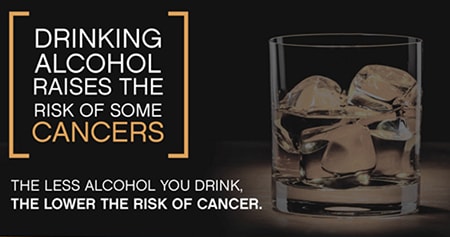
The less alcohol you drink, the lower your risk for cancer.
Drinking alcohol raises your risk of getting six kinds of cancer—
- Mouth and throat.
- Voice box (larynx).
- Esophagus.
- Colon and rectum.
- Liver.
- Breast (in women).
All types of alcoholic drinks, including red and white wine, beer, cocktails, and liquor, are linked with cancer. The more you drink, the higher your cancer risk.
What Are the Guidelines for Alcohol Use?
The Dietary Guidelines for Americans, 2015–2020, recommend that if you drink alcohol at all, drink in moderation—no more than one drink a day for women, and no more than two drinks a day for men. If you don’t drink, don’t start drinking because of any possible health benefits.
Don’t drink at all if you—
- Are under the legal drinking age.
- Are pregnant or may be pregnant.
- Have health problems that could be made worse by drinking.
- Are doing things like driving that could be dangerous with alcohol.
It’s safest not to drink if you are on any medication, including cancer treatment. If you’re taking prescription medicine, ask your doctor if it’s safe before drinking alcohol.
Why Does Alcohol Use Raise Cancer Risk?
When you drink alcohol, your body breaks it down into a chemical called acetaldehyde. Acetaldehyde damages your DNA and prevents your body from repairing the damage. DNA is the cell’s “instruction manual” that controls a cell’s normal growth and function. When DNA is damaged, a cell can begin growing out of control and create a cancer tumor.
What CDC Is Doing
- CDC is supporting states and communities through the National Comprehensive Cancer Control Program to address alcohol use in comprehensive cancer control plans.
- CDC is improving public health surveillance on excessive alcohol use, including binge and underage drinking, and harms related to it in adolescents and adults.
- CDC is partnering with the National Organization on Fetal Alcohol Syndrome and national health organizations to prevent fetal alcohol spectrum disorders.
- CDC is working with health plans, providers, and national health organizations to increase the provision of alcohol screening and brief intervention.
More Information
- Alcohol and Cancer Risk (National Cancer Institute)
- Blog post: 3 Weird Things About Acetaldehyde
- Blog post: The Surprising Link Between Alcohol and Cancer
Related Resources
Resources for Health Care Providers
- Planning and Implementing Screening and Brief Intervention for Risky Alcohol Use: A Step-by-Step Guide for Primary Care Practices[PDF-2.1MB]
- Vital Signs: Alcohol Screening and Counseling
- CDC’s Alcohol Screening and Brief Intervention Efforts
- Alcohol Misuse: Screening and Behavioral Counseling Interventions in Primary Care
Resources for Public Health Professionals






















.png)











No hay comentarios:
Publicar un comentario